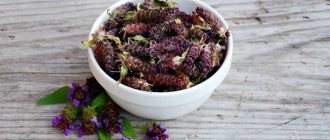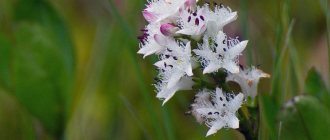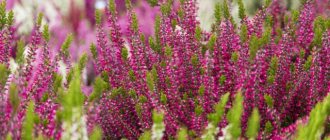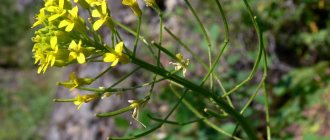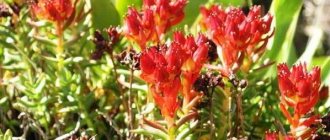Description
Caragana mane, also called maned cap and camel's tail, is a high-mountain shrub that is a medicinal plant and belongs to the legume family of the genus Caragana. This shrub is deciduous, it grows from 30 to 100 cm. The branches of the plant are thick, saber-curved or columnar. All branches are covered with petioles remaining from last year (already dead) and fresh petioles, on which there are a large number of sharp and long needles.
The length of the petiole varies from 1 to 4 cm. The leaves of Caragana mane are complex and pinnate. They are several pairs of leaf plates that have a narrow elliptical shape and are folded in half. The shoots and leaves of the plant are long-haired. Camel's tail flowers are solitary, usually orange or pink, and very rarely white. The flowers are about 3 centimeters long and are located in the leaf axils. The flower calyx of the plant has a tubular-bell-shaped shape. The fruit is a hairy small bean, which has a brownish-brown color and a sharp spike at the end.
Camel's tail grass: description of the plant
Caragana Mane
Caragana mane (Caragana jubata, Chapyzhnik, Grivka) is a perennial herbaceous shrub belonging to the legume family, the genus Caragana. Grows in the mountainous areas of China, Eastern Mongolia, Nepal, Tibet and India. In Russia, places where Camel's tail grows can be found in the Far East and Eastern Siberia, as well as in the mountainous regions of Central Asia.
All types of caragana are widely cultivated as ornamental plants and for securing slopes. Many species are honey plants. Paint was previously obtained from the bark.
The Caragana bush can reach a height of 1 meter, has long thick branches, densely planted with thorns, dead petioles of last year's foliage and dark green compound leaves. Caragana jubata blooms with single pinkish or orange flowers; by the end of summer, fruits ripen on the branches - small brown-brown beans with sharp thorns. Caragana is extremely hardy, capable of growing in poor soils and successfully surviving even very long droughts.
Flowering Caragana mane
Camel's tail grass is included in the list of rare endangered plants and is protected by the regional Red Books of the Irkutsk region and the Republic of Buryatia.
The medicinal properties of Caragana are due to its rich chemical composition, which includes the following biologically active substances:
- essential oils;
- organic acids;
- Sahara;
- flavonoids;
- carotene;
- tannins;
- ascorbic acid;
- coumarins and alkaloid compounds;
- resin.
Useful components are found in all parts of Caragana, but the roots and aerial parts, including branches and wood, are especially actively used for medicinal purposes.
Population
This culture has become widespread (you can see the maned caragana in natural conditions in the photo) in the north-west of China, in the highlands of Tibet, and Mongolia. In Russia it grows in Eastern Siberia, the Far East, the mountainous regions of Central Asia, Buryatia, and Irkutsk. Camel tail grows and develops best on high mountain peaks. For him, the subalpine and forest belt is preferable. Settles on rocks, riverbed pebbles, rocky placers. Selects sandy, loamy, well-drained soils. Caragana mane does not need a lot of moisture and soil rich in mineral fertilizers. Currently, this unique plant is on the verge of extinction. It is listed in the Red Book of the Irkutsk region and Buryatia.
Taxonomy
Caragana Fabr., 1763, Enumeratio Methodica Plantarum (Spanish) Russian. 421[4].
Kinds
The Plant List database
(2013), the genus includes 90 species[5]:
|
|
|
|
|
- Caragana acanthophylla Kom.
- Caragana aegacanthoides (R.Parker) LBChaudhary & SKSrivast.
- Caragana afghanica Kitam.
- Caragana alaica Pojark.
- Caragana alaschanica Grubov
- Caragana alexeenkoi Kamelin
- Caragana aliensis YZZhao
- Caragana alpina YXLiou
- Caragana ambigua Stocks
- Caragana arborescens Lam. typus[2] - Caragana tree, or Yellow acacia
- Caragana arcuata YXLiou
- Caragana aurantiaca Koehne
- Caragana balchaschensis (Kom.) Pojark.
- Caragana beefensis SNBiswas
- Caragana bicolor Kom.
- Caragana boisii CKSchneid.
- Caragana bongardiana (Fisch. & CAMey.) Pojark.
- Caragana brachypoda Pojark.
- Caragana brevifolia Kom.
- Caragana brevispina Benth.
- Caragana bungei Ledeb. — Karagana Bunge
- Caragana buriatica Peschkova
- Caragana camilli-schneideri Kom.
- Caragana campanulata Vassilcz.
- Caragana changduensis YXLiou
- Caragana chinghaiensis YXLiou
- Caragana cinerea (Kom.) NSPavlova
- Caragana conference Baker
- Caragana crassipina C.Marquand
- Caragana cuneato-alata YXLiou
- Caragana dasyphylla Pojark.
- Caragana decorticans Hemsl.
- Caragana densa Kom.
- Caragana erinacea Kom.
- Caragana franchetiana Kom.
- Caragana frutex () K.Koch - Caragana bush. This plant is sometimes also found in the literature under the name Dereza shrubby, although the Russian name “dereza” in botanical literature refers to the genus of plants Lycium
of the Solanaceae family - Caragana fruticosa (Pall.) Besser
- Caragana gerardiana Benth.
- Caragana gobica Sanchir
- Caragana grandiflora (M.Bieb.) DC. — Caragana grandiflora
- Caragana jubata (Pall.) Poir. — Caragana mane, or Camel's tail
- Caragana kansuensis Pojark.
- Caragana kirghisorum Pojark.
- Caragana korshinskii Kom.
- Caragana kozlowii Kom.
- Caragana laeta Kom.
- Caragana leiocalycina (Hub.-Mor.) Hub.-Mor.
- Caragana leucophloea Pojark.
- Caragana leucospina Kom.
- Caragana leveillei Kom.
- Caragana limprichtii Harms
- Caragana litwinowii Kom. — Karagana Litvinova
- Caragana maimanensis Rech.f.
- Caragana manshurica Kom.
- Caragana microphylla Lam.
- Caragana opulens Kom.
- Caragana pekinensis Kom.
- Caragana pleiophylla (Regel) Pojark.
- Caragana polorensis Franch.
- Caragana polyacantha Royle
- Caragana prestoniae RJMoore
- Caragana pruinosa Kom.
- Caragana przewalskii Pojark.
- Caragana pumila Pojark.
- Caragana purdomii Rehder
- Caragana pygmaea () DC.
- Caragana qingheensis Zhao Y.Chang, LRXu & FCShi
- Caragana roborovskyi Kom.
- Caragana rosea Maxim.
- Caragana scythica (Kom.) Pojark. — Scythian caragana
- Caragana sericea Pamp. ex Com.
- Caragana shensiensis CWChang
- Caragana sinica (Buc'hoz) Rehder
- Caragana soongorica Grubov
- Caragana sophorifolia Tausch
- Caragana spinifera Kom.
- Caragana spinosa () DC.
- Caragana stenophylla Pojark.
- Caragana stipitata Kom.
- Caragana sukiensis CKSchneid.
- Caragana tangutica Kom.
- Caragana tekesiensis YZZhao & DWZhou
- Caragana tibetica Kom.
- Caragana tragacanthoides (Pall.) Poir.
- Caragana turfanensis (Krasn.) Kom.
- Caragana turkestanica Kom.
- Caragana ulicina Stocks
- Caragana ussuriensis (Regel) Pojark.
- Caragana versicolor Benth.
- Caragana zahlbruckneri RCSchneid.
Flowering caragana (camel's tail) in the south of Buryatia, Russia
A number of species names of this genus are also listed in The Plant List
(2013) status
unresolved name
, that is, regarding these names it is impossible to say unambiguously whether they should be used as names of independent species - or whether they should be reduced to synonymy of other taxa[5].
Chemical composition
The composition of camel tail has been studied quite well by scientists. That is, all the substances included in its composition can be easily named. Based on research work, we can say with confidence that the following were identified in this plant:
- coumarins;
- resinous compounds;
- tannins;
- alkaloids;
- flavonoids;
- ascorbic acid;
- carotene;
- glycoside caraginine;
- essential oil;
- Sahara;
- organic acids;
- sterols.
Caragana mane: medicinal properties
We'll talk about contraindications later. Now let's talk about the healing properties of caragana. A plant such as camel's tail is a real miracle of nature and has very wide healing capabilities. The plant is known to have antitumor, sedative, anti-inflammatory and analgesic effects. In addition, it has the ability to protect body cells from various damaging factors, that is, it has a radioprotective effect.
Please note: caragana is of great benefit to people who experience great psychological stress, for example, people with mental work and athletes. The medicinal properties of caragana grivasta make it possible to use it to lower blood pressure and improve blood circulation. The plant is of greatest value for the treatment of inflammatory diseases of the genital area in women; it is used for leucorrhoea, metrorrhagia and menorrhagia, menstrual irregularities, adnexitis, cervical erosion, etc.
Using caragana mane in gardening
Some gardeners plant camel tail on their plot. The grass is unpretentious, tolerates drought well and grows quickly in direct sunlight, which is why this plant is loved. In addition, it can be propagated in several ways: by seeds, dividing the bush and layering. Caragana mane greatly transforms during the flowering period, so it can be used to decorate gardens. In landscape design, the plant looks great both in group and single plantings.
It is worth noting that the clinical pharmacological properties of the maned cape have not been studied. But its long-term use in folk medicine fully proves its effectiveness in various diseases.
Source: fb.ru
nature
A remedy for the treatment of sepsis
This remedy is used to increase the effectiveness of traditional treatment, but in no case replaces it! Take 12 g of crushed shrub wood, pour a glass of cold water and place on the fire, after the mass boils, you need to cook for another 7 minutes. Remove from heat, leave for about an hour, then strain. Take two large spoons orally before meals, three times a day. The course should be selected individually.
Means for douching and rinsing the mouth
In order to eliminate the inflammatory process on the mucous membranes, it is necessary to prepare the following remedy: 2 tbsp. l. crushed caragana mane roots, pour 300 ml of just boiled water, leave for 120 minutes. We filter the broth, use it for rinsing once every 30 minutes, the course is 5 days. Douching should be done four times a day, the course should be continued for 10 days.
Caragana mane: use in medicine
Pharmacy collection Caragana grivastaya
Caragana grivastaya is one of the oldest medicinal plants known to folk medicine. The unique chemical composition allows the active use of all its components for the benefit of human health. To prepare a medicine from Caragana, you do not need complex equipment or many hard-to-find ingredients, you just need to know the correct dosage of the active substance and the method of using the resulting drug.
Caragana Grivastaya is listed in the Red Book. When procuring raw materials, it must be handled with care. The twigs are collected during flowering (June-July) along with flowers and leaves, and dried under a canopy. During harvesting, the root is dug up a little, only a small part is taken from it.
For influenza and acute respiratory infections, a decoction is prepared from the roots or branches of Caragana. To prepare, take 10 g of crushed medicinal raw materials, add a glass of water, boil for 5 minutes over low heat, then let it brew for about an hour. Take the resulting decoction, 2 tbsp. spoons three times a day. The duration of the course of treatment is determined individually.
For hypertension and to strengthen the heart and blood vessels, it is worth trying a decoction of Caragana branches. It is prepared like this: 2 tbsp. Heaped spoons of crushed medicinal raw materials are poured into a glass of water, boiled over low heat for about 5 minutes, after which the pan with the broth is removed to a warm place for one hour. Strain before use. The decoction should be taken a quarter glass three times a day. The duration of treatment is until noticeable improvements in the patient’s condition occur. This medicine also helps well with insomnia caused by nervous overstrain.
For gargling and mouthwash in case of inflammatory diseases, an infusion of Camel's tail roots is prepared. To do this, 2 tablespoons of crushed medicinal raw materials are poured into 300 ml of hot water, left to infuse in a warm place for about 2 hours, then filtered and used to rinse the mouth every half hour for 5 days. This decoction is also suitable for douching for gynecological diseases; these procedures are also carried out in a course for 10 days, 4 times a day.
Where else is the plant used?
Let's consider what other treatment methods are used using dried caragana mane herb. For severe sore throat and stomatitis, the plants are brewed with boiling water and used as an effective rinse. A decoction of camel tail, which should be consumed half a glass up to four times a day, will help get rid of radiculitis and sleepless nights. Caragana decoction is excellent for treating various skin diseases and has a beneficial healing effect on fresh wounds and cuts.
Traditional medicine of Tibet
In ancient Tibet, caragana decoction was used to thin blood clots and relieve fever. The small-leaved variety of the plant was specially dried in order to expel excess bile from the body. This component is now found in some Tibetan medicines. By the way, the plant is used as an additional remedy in the treatment of oncology. The use of caragana helps to activate the body’s immune properties, destroy harmful cancer cells, and prevent the occurrence of metastases. After experiments were carried out on animals, it was possible to identify the hepatoprotective qualities of the plant, and it is being studied as an effective remedy for combating liver diseases - hepatitis and cirrhosis.
Reviews
People who have used a decoction of this unique herb for treatment and prevention leave a large number of positive reviews. For example, they note that the use of infusions and decoctions has a beneficial effect on the entire body. Caragana has proven itself well as a medicine for various lesions of the oral cavity. Folk remedies are used to treat tumors in the gastrointestinal tract, respiratory and reproductive systems. Caragana is often used to treat diseases associated with damage and inflammation of the mucous membrane. It is used to treat ailments such as pancreatitis, stomach and duodenal ulcers, inflammation of the bile ducts, and gastritis. The plant is able to gently restore damaged tissue and eliminate pathogenic bacteria.
In gynecology, the camel tail has also found its application. Thanks to its anti-inflammatory and antimicrobial properties, it helps cope with various diseases, eliminates various inflammations, and has a mild hormone-restoring effect on almost the entire body. In addition, it helps to cleanse the uterus and its appendages from all kinds of benign formations, according to reviews. Herbalists recommend using this plant for patients with uterine fibroids, endometriosis, and erosion. Some patients note that this plant helps cope with infertility.
Caragana mane also relieves diseases such as hemorrhoids. This happens because it relieves pain, eliminates bleeding, and also allows you to shrink the hemorrhoid.
Camel Tail Grass: reviews
Adherents of traditional medicine who have used caragana as a medicinal product leave only positive reviews about its effect on health. Thus, many note that decoctions and infusions of the Camel's Tail herb have a general strengthening and tonic effect on the body, awaken vitality, improve the quality of sleep and skin condition.
You can grow Caragana Mane in your garden. She loves light sandy or loamy soils and well-lit areas. The main care for it comes down to loosening and mulching the soil under planting and pruning.
Caragana has also proven itself well in the treatment of diseases of the digestive system accompanied by inflammatory processes, such as stomach ulcers, gastritis and pancreatitis, and inflammation of the biliary tract. An infusion of this herb promotes faster restoration of damaged mucous membranes and tissues and effectively fights pathogenic bacteria.
Camel's tail also helps to cope with such a delicate problem as hemorrhoids. A decoction of the herb soothes the pain that accompanies the acute stage of this disease, stops bleeding, and helps to reduce and resolve hemorrhoids.
All articles about caraganas on the site can be read by following this link...
Despite the fact that Caragana jubata has long been known in medicine as an extremely useful and effective medicine that helps in the treatment of many diseases, you should first consult with your doctor about its use in certain situations.
Published in section
Health
, in subsection
Medicinal plants
, 10.04.2014,
This small miracle of nature, growing in Tuva, Mongolia, and Buryatia, has the widest healing potential.
Medicinal properties of camel's tail or caragana mane
Decoctions are used to gargle for sore throats and diseases of the oral cavity.
Mild antipyretic. It is absolutely not necessary to stuff children with heaps of “deficient” pills (from which it is not yet known whether there is more harm or benefit). 1-2 tbsp is enough. Infuse spoons “in the tail” in a glass of boiling water, drink it like tea, and the temperature will be “removed by hand.”
If the temperature is “off the charts”, add goat willow bark, lingonberry shoots or berries to the “tail”.
Decoctions of camel tail are used for: colds, flu, acute respiratory infections, bronchitis, stomach and duodenal ulcers, hemorrhoids, prostatitis (enemas), rheumatism, eczema, acne, pustular skin diseases, pyoderma, neurodermatitis and other dermatoses, inflammation of the female genitalia spheres, menstruation disorders. An effective preventive and therapeutic agent for hepatitis and liver cirrhosis.
Residents of some regions of Khakassia use the medicinal properties of this plant for disorders of the nervous system, twitching of the muscles of the arms, legs, face, necrosis of the heart to prevent epileptic seizures, and urinary incontinence in children.
In his small practice, he recommended complex treatment for patients with lung sarcoma (cancer): bioenergetics, curly borer, Icelandic cetraria, tsenya, “in the tail.”
Directions for use and dosage:
Camel's tail tincture
: 50 g “at the tail” per 0.5 l. 40 gr. alcohol, leave in a sealed container in a warm place for 10 days.
Method of treatment: 30 drops 3 times a day before meals. The tincture is also used for rinsing, and is diluted with water in a ratio of 1:5, 1:10.
Oh creature
: pour one tablespoon of crushed raw materials into a thermos, leave for 4 hours.
Method of treatment: take the decoction 3 times a day, half an hour before meals, 1/3 cup.
Alexey Ermyulchik, healer
Syn.: mane, camel's tail, maned cape.
Caragana mane is a deciduous shrub of the legume family that grows in the mountains. It has healing properties used in folk medicine. Caragana mane is also used for landscape gardening in group plantings, due to its unique appearance.
Flower formula
Caragana mane flower formula: Ch(5)L1+2+(2)T(9)+1P1.
In medicine
Caragana mane is not included in the Pharmacopoeia of the Russian Federation and is not used by official medicine due to poor knowledge and lack of clinical data. However, the plant is widely used in traditional medicine of many peoples, as well as in herbal medicine.
Contraindications and side effects
Caragana mane is contraindicated in case of individual intolerance to the components. It is also not recommended to take caragana during pregnancy, breastfeeding and childhood. To avoid negative consequences, consult your doctor before using the plant.
In gardening
Caragana mane is a fairly hardy and drought-resistant plant. It looks very beautiful during the flowering period, prefers a sunny location, sandy and loamy drained soil. It propagates not only by seeds, but also by layering and dividing the bush.
When wintering under snow, caragana may freeze the tops of young shoots. Therefore, when planting, you need to choose a place where the plant will be maximally protected from the cold wind.
In landscape design, caragana mane can be used both in single and group plantings.
In other areas
Caragana mane acts as a system-forming plant in two types of mountain ecosystems:
1) Kashgar-Tienshan dwarf-spruce ecosystems with grass and moss cover.
2) Dzungar-North Tien Shan dwarf-spruce ecosystems with grass and moss cover with Siberian juniper and in Terskey Alatau in combination with cryophyte meadows.
Caragana jubata (Pallas) Poiret. - a representative of the genus of deciduous shrubs or small trees Caragana; legume family (Fabaceae).
Caragana mane is a winter-hardy shrub with a height of 30 to 100 cm. The branches are thick, columnar, saber-shaped, densely covered with last year's dead needle-like petioles and living young petioles with long needles. The length of the petioles is 1.5-4 cm, hairy, with a spine at the end. Subsequently, the petioles harden and turn into straight spines. The non-deciduous and hardening stipules are triangular-lanceolate, leathery and hairy, also with a spine at the end. The leaves are pinnate with 4-6 pairs of narrow elliptical or linear leaflets folded along the midrib. Leaves with shoots are long-haired. The flowers are solitary, pink and orangish, rarely white, large, about 30 mm long, located in the axils of the leaves. The calyx is campanulate-tubular, sphenoid, with 5 teeth. The corolla is sharply zygomorphic, moth-like. The upper petal is a flag, wide, the two lower ones are fused by the upper halves into a boat, and the two side petals are wings, divided into a plate and a nail. There are ten stamens, nine of them are fused and one is free, and there is one pistil. The formula of the caragana mane flower is Ch(5)L1+2+(2)T(9) + 1P1. The fruit is a small hairy bean of brownish-brown color, with a hard, sharp spine. Caragana seeds are spotted, spherical, ripening time is September. The flowering period of caragana mane is June-July.
Caragana mane is a species with a pan-Asian range. In Buryatia it is found in the following areas: Muisky - r. Kelyana, b. Bamboo; North Baikal - r. Inamakit; Bauntovsky - 3 km upstream from the bridge over the river. Taloy s. Bagdarin (Bogdarino), b. Uakit, b. Vitimkan (environment of the Ivanovsky mine); Kurumkansky - the sources of the rivers Barguzin, Nyundyu, Argoda, the city of Kavokta, Dzherginsky reserve, r. Davachan; Okinsky - the rivers Obtoi, Sentsa, Zhakhna, Dibi, Urik (between the village of Urik and the mouth of the Dayalyk river), Sagan-Sair; the rivers Oka, Kitoi (in the vicinity of the village of Samarta), Susar, Shumak; Tunkinsky ridge, 12 km north of the village. Arshan; Tunkinsky - the rivers Irkut, Khubuty, Bugovek, Maly Bugotoy, etc.; Zakamensky - along the river. Tsakirka, s. Dalahai; Dzhida ridge, Tsagan-Bilchir valley, Khangarul ridge, between the Khamar-Khudu pass and the Ulan-Sardyk peak. In addition to Buryatia, it also grows in the Irkutsk region, Transbaikal, Krasnoyarsk territories, in the Republics of Altai, Tyva, Sakha (Yakutia) and in the Far East. Outside the Russian Federation - in Central Asia, Mongolia, China, Bhutan, India, Nepal.
Regions of distribution on the map of Russia.
Caragana's medicinal raw materials are all above-ground parts of the plant.
Harvesting of caragana mane is carried out throughout the year, including in winter, but raw materials from the spring harvest (during the flowering period) or autumn harvest are considered the best.
Harvesting is done by cutting the plant at some distance from the ground. It is strictly forbidden to pull out the entire caragana by the roots; this destroys the population of a rare plant listed in the Red Book.
The collected raw materials are dried in ventilated warm rooms or under canopies, tied in small bundles and hung on stretched ropes.
Sometimes, instead of Caragana arborescens, raw materials of one of the plant forms are sold: common yellow acacia or Caragana arborescens. Be careful.
The plant contains tannins, essential oil, saponins, flavonoids and alkaloids. Coumarins, organic acids, resinous substances, sugars and sterols were also found in caragana mane. In the total of alkaloids, 4 individual alkaloids were found, in the total of coumarin derivatives - 6 individual substances, and in the total of flavonoids - 9 substances, including myricitin.
Pharmacological properties
Caragana mane has an antitumor, anti-inflammatory, sedative and analgesic effect, and has a radioprotective effect - it protects the body's cells from damaging factors. Caragana relieves fatigue well and restores performance. The plant is especially useful for athletes and people of mental work who experience strong mental stress. The rhizome of caragana mane is used to lower blood pressure and improve blood circulation. But the most valuable effect of caragana mane is in the treatment of inflammatory diseases of the female genital area: cervical erosion, metro- and menorrhagia, adnexitis, leucorrhoea, menstrual disorders and other female diseases.
Use in folk medicine
Caragana mane is one of the oldest medicinal plants used in traditional Tibetan medicine.
Traditional healers of Eastern Siberia, especially the Irkutsk region and the southwestern regions of Buryatia, widely use the aerial part of the plant for a wide variety of inflammatory diseases.
Caragana decoction is used to make mouth rinses for sore throats, diseases of the gums, mucous membranes, abscesses, etc. Externally, a decoction of caragana is used for wounds, especially purulent ones, for boils, fistulas, skin diseases, including eczema, pustular skin diseases, acne, pyoderma, neurodermatitis and other dermatoses.
Doctors recommend taking caragana decoction internally for colds, diseases of the gastrointestinal tract, hemorrhoids, stomach and duodenal ulcers, and rheumatism.
Caragana is successfully used in the treatment of inflammatory diseases of the female genital area - cervical erosion, metro- and menorrhagia, leucorrhoea, menstruation disorders, etc.
Traditional healers in some cases recommend combining external and internal use of caragana preparations.
The genus Caragana contains about 80 species. The name comes from the Kyrgyz folk name for black-eared foxes living in the thickets of Caragana frutex: “kara” - black, “gana” - ear.
For the truly unique healing capabilities of the plant, the Mongols call it “altan khara-gana” - golden caragana.
The maned caragana is a rare endangered species and is listed in the Red Books of Buryatia and the Irkutsk region.
1. Brekhman I. I., Kurentsova G. E. Medicinal plants of the Primorsky Territory. Vladivostok, 1961.
2. Burmistrov A. N., Nikitina V. A. Honey plants and their pollen: Handbook. - M.: Rosagropromizdat, 1990. - P. 81. - 192 p. — ISBN 5-260-00145-1.
3. Varlakov M. N. Medicinal plants of Eastern Transbaikalia. - Chemical and pharmaceutical industry, 1932, No. 2,3.
4. Semenov S. R., Telyatyev V. V. Medicinal plants of Eastern Siberia. Irkutsk, 1966.
Good to know
Author:
Author:
see also
You watched
Return to list
Caragana mane is a shrub with increased winter hardiness, capable of growing up to 1 m in height. It has long branches covered with small petioles. The leaves of the plant have a felt structure, slightly pubescent below. The beautiful caragana blooms at the end of spring - beginning of summer, in June. Its soft yellow flowers are collected in small bunches.
It bears unique fruits - cylindrical beans that ripen at the end of July. This beautiful fruit does not grow more than 4 cm. Many traditional healers grow and collect this unique plant due to its healing qualities. The official name of this unusual shrub is caragana jubata; common people know it as camel's tail.
It is possible to discover a unique plant in the vast territory of Central Asia, in Mongolia, India, and China. In Russia, the lush shrub is found in Buryatia, in the Far East.

